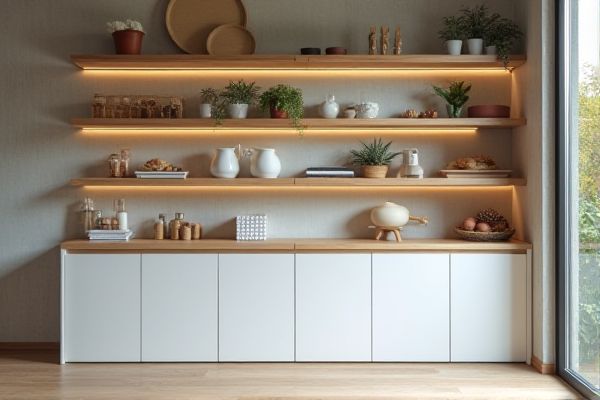
Open shelving offers easy access and showcases your items, creating an airy, spacious feel, while closed cabinets provide concealed storage that protects belongings from dust and clutter. Explore the rest of the article to discover which option best suits your space and lifestyle.
Table of Comparison
| Feature | Open Shelving | Closed Cabinets |
|---|---|---|
| Accessibility | Easy, items visible and reachable | Moderate, items behind doors |
| Storage Capacity | Limited, mainly display-friendly items | High, suitable for all items |
| Maintenance | Requires frequent dusting | Lower dust exposure |
| Aesthetic | Modern, open, and airy look | Clean, minimalistic, hides clutter |
| Cost | Generally lower installation cost | Typically higher due to doors and hardware |
| Customization | Limited to shelf adjustments | Flexible with shelves, drawers, and inserts |
| Privacy | Low, items are visible | High, contents hidden |
Introduction to Open Shelving and Closed Cabinets
Open shelving offers easy access and visual display, making it ideal for frequently used items and decorative pieces, while closed cabinets provide concealed storage that protects belongings from dust and creates a streamlined kitchen appearance. Your choice depends on balancing functionality and aesthetics, with open shelving promoting openness and closed cabinets enhancing organization. Both storage solutions play a critical role in optimizing kitchen space according to your lifestyle needs.
Aesthetic Appeal: Visual Impact Compared
Open shelving creates an airy, modern aesthetic by displaying items openly, enhancing your kitchen's visual appeal through accessible decor and vibrant dishware. Closed cabinets offer a clean, uniform look that conceals clutter, providing a streamlined and polished appearance. The choice between open shelving and closed cabinets significantly affects the room's ambiance, balancing openness and order to suit your design preferences.
Storage Efficiency and Organization
Open shelving offers easy access and visibility, making it ideal for frequently used items and aesthetically arranging decor, but it may require more frequent tidying to maintain organization. Closed cabinets provide superior storage efficiency by concealing clutter and protecting contents from dust, optimizing space with adjustable shelves and compartments tailored to your needs. Your choice depends on balancing accessibility versus maximizing organized storage capacity in your kitchen or living area.
Accessibility and Convenience
Open shelving provides immediate accessibility, allowing users to quickly grab items without the barrier of doors, enhancing convenience in busy kitchens or workspaces. Closed cabinets protect contents from dust and damage while offering a cleaner, more organized appearance but may require extra effort to access items. Choosing between open shelving and closed cabinets depends on balancing easy reach with protection and aesthetics tailored to specific household needs.
Maintenance and Cleaning Considerations
Open shelving requires frequent dusting and regular organization to maintain a clean, clutter-free appearance, as exposed surfaces attract dust and grease more easily than enclosed spaces. Closed cabinets offer protection against dirt and grime, reducing cleaning frequency but can accumulate grime inside if not occasionally wiped down. Your choice depends on how much time you can dedicate to upkeep and whether you prefer easy access or minimal maintenance.
Cost and Installation Differences
Open shelving typically costs less than closed cabinets due to reduced materials and simpler design requirements, making it a budget-friendly option for kitchen renovations. Installation of open shelves is generally quicker and less complex, requiring fewer tools and labor compared to the precise alignment and hardware needed for closed cabinet doors. Closed cabinets incur higher expenses not only from additional materials like hinges and handles but also from longer installation times that demand professional skills for proper fitting and finishing.
Customization and Design Flexibility
Open shelving offers unparalleled customization and design flexibility, allowing you to display decorative items, frequently used kitchenware, and personalized collections that enhance your space's aesthetic. Closed cabinets provide versatile storage options with adjustable shelves and various door styles, enabling tailored organization while maintaining a clean, uncluttered look. Combining both options maximizes functionality and style, adapting to your unique needs and evolving interior design preferences.
Space Perception and Room Size Effects
Open shelving enhances space perception by creating an airy, less obstructive visual effect that makes rooms appear larger and more open. Closed cabinets provide a solid surface that can visually shrink a room, but they offer the benefit of hiding clutter, which helps maintain a neat aesthetic. For small or compact spaces, open shelving maximizes openness, while closed cabinets contribute to a more organized and streamlined environment.
Ideal Uses for Open Shelving vs Closed Cabinets
Open shelving is ideal for displaying frequently used kitchenware, decorative items, and easy access to everyday essentials, enhancing both functionality and aesthetic appeal. Closed cabinets provide concealed storage for bulky appliances, cleaning supplies, and less attractive items, maintaining a clutter-free environment. Combining both storage types optimizes organization by balancing accessibility with hidden storage in kitchen or living spaces.
Choosing the Best Option for Your Space
Open shelving offers easy access and displays your decor, making small spaces feel larger and more inviting. Closed cabinets provide concealed storage, reducing visual clutter and protecting items from dust, ideal for a tidy, minimalist look. Your choice depends on the balance between accessibility, aesthetics, and the amount of hidden storage your space requires.
 homyna.com
homyna.com